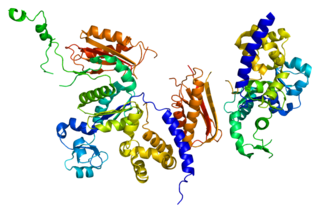
Robert G. Roeder is an American biochemist. He is known as a pioneer scientist in eukaryotic transcription. He discovered three distinct nuclear RNA polymerases in 1969 and characterized many proteins involved in the regulation of transcription, including basic transcription factors and the first mammalian gene-specific activator over five decades of research. He is the recipient of the Gairdner Foundation International Award in 2000, the Albert Lasker Award for Basic Medical Research in 2003, and the Kyoto Prize in 2021. He currently serves as Arnold and Mabel Beckman Professor and Head of the Laboratory of Biochemical and Molecular Biology at The Rockefeller University.

DNA polymerase II is a prokaryotic DNA-dependent DNA polymerase encoded by the PolB gene.

The TATA-binding protein (TBP) is a general transcription factor that binds to a DNA sequence called the TATA box. This DNA sequence is found about 30 base pairs upstream of the transcription start site in some eukaryotic gene promoters.
Leonard Solomon Lerman was an American scientist most noted for his work on DNA.
Julius Marmur was an American molecular biologist who made significant contributions to DNA research. His discovery, while working in the laboratory of Paul Doty at Harvard University, that the denaturation of DNA was reversible and depended on salt- and GC-content, had a major impact on how scientists thought about DNA, and how DNA could be handled in vitro. This discovery was a cornerstone of the recombinant DNA revolution.

DNA-directed RNA polymerase II subunit RPB2 is an enzyme that in humans is encoded by the POLR2B gene.

DNA-directed RNA polymerase II subunit RPB4 is an enzyme that in humans is encoded by the POLR2D gene.

DNA polymerase kappa is a DNA polymerase that in humans is encoded by the POLK gene. It is involved in translesion synthesis.

Frizzled-2(Fz-2) is a protein that in humans is encoded by the FZD2 gene.

Frizzled-5(Fz-5) is a protein that in humans is encoded by the FZD5 gene.

General transcription factor IIH subunit 4 is a protein that in humans is encoded by the GTF2H4 gene.

RNA polymerase II subunit A C-terminal domain phosphatase is an enzyme that in humans is encoded by the CTDP1 gene.

General transcription factor 3C polypeptide 1 is a protein that in humans is encoded by the GTF3C1 gene.

Poly(A) polymerase alpha is an enzyme that in humans is encoded by the PAPOLA gene.

Mediator of RNA polymerase II transcription subunit 7 is an enzyme that in humans is encoded by the MED7 gene.

ELAV-like protein 2 is a protein that in humans is encoded by the ELAVL2 gene.

Peroxisomal proliferator-activated receptor A interacting complex 285, also known as PRIC285, is a human gene.

Elongator complex protein 2 is a protein that in humans is encoded by the ELP2 gene.

Poly(A) polymerase gamma is an enzyme that in humans is encoded by the PAPOLG gene.
A nicking enzyme is an enzyme that cuts one strand of a double-stranded DNA or RNA at a specific recognition nucleotide sequences known as a restriction site. Such enzymes hydrolyze (cut) only one strand of the DNA duplex, to produce DNA molecules that are “nicked”, rather than cleaved.
















